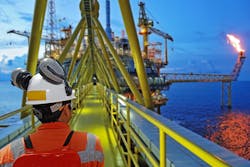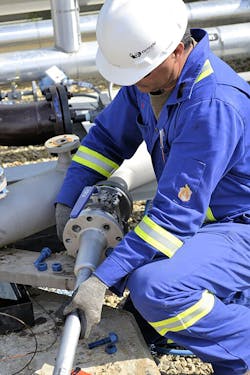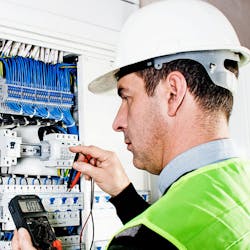The Internet of Things (IoT), the global network of devices connected directly to the internet, is poised to revolutionize industries across the world, significantly increasing the capability of businesses to monitor and measure an almost unlimited number of objects.
For asset managers in industries that flare high volumes of excess gas including oil and gas and chemicals, IoT connectivity will enable data from machine-to-machine communication to be collected and analyzed remotely. This provides actionable insight for better business decisions and greater visibility to better manage and optimize large-scale operations.
Flared natural gas produces more than 300 million tons of CO2 emissions every year, or the equivalent of approximately 77 million cars. Alternatively, if the gas were captured and used to generate power, it would provide more electricity than the annual consumption of the African continent. Harnessing the power of remote asset monitoring will be crucial for gas flaring operations. Operators need to drive new value from operations to maintain revenue while meeting increasingly stringent emissions legislation. Operators can harness significant savings in equipment maintenance while optimizing plant emissions to derive new revenue streams from the capture, storage and sale of excess gas.
A quality engineer installs a new flare meter.
What is remote monitoring?
Many high-volume flaring operations occur in hostile or hazardous locations that pose a threat to the engineers tasked with maintaining equipment and collecting data. On-site explosions, for example, can be caused by a sudden release of gas under pressure or other anomalies during normal operation. In addition, the cost associated with maintaining and managing assets in dangerous environments is significant; A typical oil rig — where access is only possible by helicopter — houses 50 to 100 employees on-site working 12-hour shifts.
Remote monitoring means data collected from on-site equipment — connected directly to the internet — can be streamed to any location around the world. Cloud technology — where software is stored on a central server and accessed via the internet — transformed how businesses access, pay for and utilize enterprise software.
Accessing data from remote assets using cloud software is fundamentally changing asset management, empowering operators with increased visibility and analytics over plant data.
It gives operators the ability to monitor equipment installed on many local assets — from offshore oil rigs to chemical production plants — and transmit the data in real time to be analyzed in a completely separate location. Flaring data from a number of sites can be fed into a continuous emission monitoring system (CEMS) to enable an operator to collect, record, analyze and report data remotely and in real time.
Why is remote monitoring important?
External data feed into CEMS software, significantly reduce cost and remove the need for an on-site engineer to manage the hardware and record data. Data is more secure because it is stored on a remote server, and it is not dependent on the reliability of the on-site machine.
CEMS allows operators to take control of data by presenting a live view of operations. While this allows operators to quickly optimize operations in real time, the most significant cost benefit comes from maintenance savings. Remote monitoring and measurement over the cloud enables passive, ongoing monitoring for maintenance requirements so action is only necessary when intervention is required.
When the condition of equipment changes and action may be required, notification occurs remotely and an engineer can be booked to attend. This is significantly cheaper than stationing an engineer on-site continuously, maximizing engineer productivity and limiting costly process requirements such as security vetting. Condition-based maintenance (CBM) also allows for immediate action in the case of an emergency — updating software, shutting down failing or faulty systems, or extracting on-site personnel immediately if an explosion is possible.
CBM in this way means operations in hostile and hazardous locations can be managed more efficiently, enabling organizations to control risk more effectively and vastly reduce routine maintenance costs. With increasing pressure to optimize business strategies under financial constraints, CBM can support the necessary transition to management and emissions reduction.
The cost of restarting
Plant shutdown for major maintenance work is the most expensive maintenance procedure for operators. Utilizing CBM to reduce the likelihood of having to undergo this process will significantly minimize plant maintenance costs. Production loss, plant turnaround costs and reduced employee productivity all contribute to what — in the most serious cases — can damage business.
In July 2016, Westlake Chemical Corporation announced that its Calvert City complex in Kentucky was undergoing a restarting procedure following an unexpected shutdown that occurred after a mechanical failure at its ethylene unit. This resulted in a complete outage, halting all chemical production. The financial impact of this shutdown is estimated to be in excess of $40 million. Westlake Chemical Corporation said it will affect its second and third quarter financial results.
The ongoing effects of the incident will last more than a year, demonstrating how even a short shutdown period can have a significant impact on business. A complete shutdown can consume a yearly maintenance budget in less than five weeks, and often the complexity of the shutdown increases over time, becoming increasingly costly and more difficult to manage.
Without maintenance, equipment will fail and impact business performance. Unscheduled outages can cost more than 10 times as much as a scheduled outage and operators taking a CBM approach — through remote asset monitoring — can minimize the risk of a plant shutdown by addressing potential faults when alerts are raised and before maintenance is required.
Control over emissions
Traditionally emissions data was recorded locally, transported, analyzed remotely and reported on a periodic basis. Remote asset monitoring allows equipment to be monitored and measured in real time and emissions data to be streamed to CEMS software continuously. This enables operators to track trends over time, report emissions data to a high degree of accuracy and minimize carbon tax obligations.
Equipment must be maintained and calibrated to ensure measurement is accurate.
Increased control and visibility over emissions data can also be used to gain business advantage by driving new revenues from existing processes. For example, data can be collated and compared from every site in an operation to optimize the flaring process and support continuous improvement. Best practice from low-emission sites can be implemented in high-emission sites to improve overall efficiency.
Consider the typical oil rig. Real-time data streams can be analyzed to identify exactly how it performs at various times of the year, giving visibility over, for example, how seasonal weather impacts performance. This enables predictive action to be taken when similar conditions arise in the future. For accurate predictions this requires access to long-term data trends from on-site assets and weather data. The most extreme and business-impacting weather may only occur every six years. It is therefore crucial that data relating to a previous extreme storm is available for analysis so correct precautions can be taken in the future if the same conditions arise. The best time to start collecting data was 10 years ago. The next best time is now.
The global move to reduce flaring
Increasing regulatory scrutiny of emissions in high-flaring industries means it is crucial that flaring only takes place when absolutely necessary. Any gas released into the atmosphere should be accurately measured, recorded and reported. Global regulations and targets — such as those agreed at the Paris Climate Conference (COP21) in 2015 — mean that emissions reporting requirements will become increasingly stringent.
Until now, gas flaring measurement has predominantly been regulatory, with operators reporting periodically under local regulations for tax purposes. As the global movement to reduce flaring continues to gather pace, reporting will become a national priority and businesses will need to adapt, becoming more efficient in the face of increasing administration costs and carbon taxation. Remote asset monitoring to track flaring volumes enables operators to utilize this information to derive valuable insight and inform the business strategy during the transition.
Taking the oil rig example again, if flaring only happens after certain maintenance procedures, real-time data can help manage the process more effectively. This will reduce the volume of wasted gas and carbon tax obligations for the reporting company. Over time the operator can predict which rigs will flare more than others so he or she can implement gas capture technology more effectively. A cost (taxation) could then be turned into revenue (gas sales).
Conclusion
Remote asset management has a central role to play in the move toward ubiquitous infrastructure connectivity. It will be crucial, however, for IoT applications to include built-in fail-safes to ensure immediate escalation if the monitoring systems are compromised.
The potential to enhance operators’ abilities to make accurate decisions, reduce cost, improve capabilities and reduce risks, is clear. More effective risk management can be achieved by deploying cloud-based measurement tools that provide a snapshot of any issue in the short term but, in the long run, will help businesses identify trends that inform strategy and support business growth. In high-flaring industries that can experience a host of ancillary benefits through connected infrastructure monitoring, there is no time to lose.
Lana Ginns is the marketing manager at Fluenta, a provider of ultrasonic flow measurement for the oil and gas and chemicals industries. Ginns has a passion for languages and is fluent in German, English, Spanish and French. Her extensive marketing experience, which covers business to consumer and business to business, ranges from complex engineering equipment to essential oils. For more information on flare gas measurement, visit fluenta.com.




